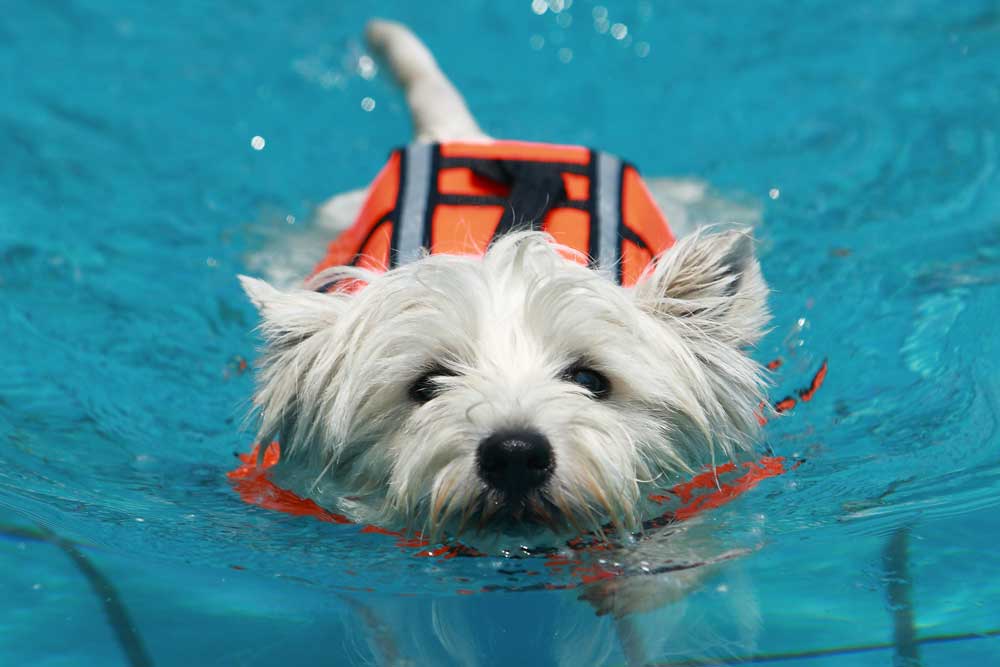Is your dog recovering from an injury or surgery, or in need of some extra exercise? A hydrotherapy program could hasten his return to fitness.
Warm water therapy for humans dates back to antiquity. The first use of hydrotherapy for animals involved horses. When racehorses swam as part of their rehabilitation, they recovered from injuries more quickly and stayed fit for racing. The first equine hydro-treadmill was developed in the early 1970s.
In the mid-1980s, the hydro-treadmill became available to human patients. And in 1998, TOPS Veterinary Rehab near Chicago introduced the world to hydro-treadmill use for canine rehabilitation. Since then, hydrotherapy, whether in a pool or an underwater treadmill, has proved to be a valuable tool for dogs in need of physical rehabilitation following injury or surgery.
What hydrotherapy offers
Aquatic therapy relies on the properties of water to help with the rehabilitation process. It does this in several ways.
- Water provides buoyancy that aids in rehabilitating weak muscles and painful joints. This buoyancy allows the patient to stand and exercise while minimizing the weight bearing on sore joints. If a dog is immersed to the middle of his chest, his joints are bearing only 38% of the weight they would bear on dry land. With less of a load on painful joints, the dog is able to exercise more comfortably.
- When an animal is immersed in water, it exerts constant hydrostatic pressure on his body. This is particularly useful for swollen joints or limbs and other tissues that are retaining fluid. Not only does the water pressure reduce swelling, it also stimulates nerve receptors in the skin. This stimulation decreases the animal’s pain perception and allows him to exercise with considerably less discomfort
- The viscosity of water provides resistance to movement. It’s harder for the animal to move through water than through air. This resistance is used to strengthen muscles and improve fitness. Along with water’s buoyancy, its viscosity provides support for unstable joints. For example, a paralyzed dog is more willing to walk in water than on land because the water holds him up and prevents him from falling. This greatly reduces his anxiety toward exercise. If the dog is weak, he is able to move more comfortably in water than on land. The resistance of the water allows him to get a more intense workout in a shorter period of time.
- Exercising in water has many additional benefits. It improves strength and muscular endurance, cardiovascular fitness, range of motion and well being. Most dogs find water exercise, particularly swimming, to be fun. Those recovering from anterior cruciate surgery, fractures, neurological conditions, tendon or ligament injuries benefit greatly from aquatic therapy as part of their rehabilitation. Overweight, arthritic and senior dogs, or dogs with hip dysplasia or spondylosis (a disease of the spine) are also candidates for aquatic therapy. Even dogs that do not suffer from any of these diseases can benefit from the increased level of fitness aquatic therapy provides.
Necessary precautions
Hydrotherapy does not mean throwing your dog in a pool or onto a hydro-treadmill, and watching him try to swim around. Some precautions have to be taken before instituting a hydrotherapy program. Dogs with open wounds or sores, or those with breathing difficulties or heart disease, are not candidates for aquatic therapy. If the dog panics in water, aquatic therapy may not be right for him; he may injure himself by thrashing around. Lifejackets, swim buddies and competent aquatic therapists may help a panicky dog get used to swimming, or an underwater treadmill might be a better choice. The therapist must determine the dog’s fitness level, as swimming in particular can be very strenuous. After surgery, it’s common for a dog to be able to swim or walk on an underwater treadmill for only a short time, due to fatigue.








